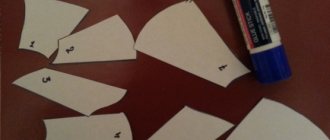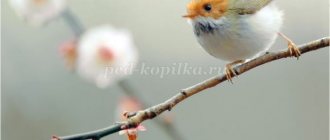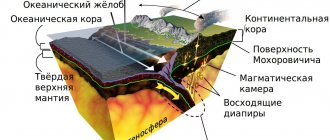"Winter in the Forest"
Goal: to systematize children’s knowledge about winter and winter phenomena.
Tasks:
Correctional and educational:
— clarify and expand the idea of winter and its signs; — clarify and activate the vocabulary on the topic “Winter”: learn to answer questions, compose sentences grammatically correctly, select feature words and action words; — learn to form nouns with diminutive suffixes; improve skills in using prepositional-case constructions.
Correctional and developmental:
- learn to express your thoughts correctly and accurately; - develop visual and auditory attention, thinking; articulatory motor skills, coordination of speech with movement; facial muscles; - develop speech breathing, vocal range; - develop phonemic hearing; — learn to use prepositions denoting the spatial arrangement of objects.
Correctional and educational:
— to develop skills of cooperation, mutual understanding, goodwill, independence, initiative, and responsibility.
Equipment:
Laptop, presentation, projector, screen, cotton balls, artificial Christmas trees, paper balls with pictures, audio recording of bird voices.
Summary of an integrated lesson for children of the senior group
Purpose of the lesson:
Develop the ability to perceive the characteristic features of winter through the integration of areas: cognition, communication, safety,
health, music, physical education, artistic creativity.
Tasks:
— Expand children’s understanding of the characteristic signs of winter.
— Activate the vocabulary on the topic “Winter.”
— To arouse children’s interest in experimentation, to be able to analyze, compare, and draw conclusions.
— Develop physical activity and fine motor skills through playful motor tasks.
— To develop children’s creative imagination, artistic perception, the ability to see and feel the state of winter nature, expressing their impressions in children’s creativity.
Materials and equipment:
Cups of water and snow according to the number of children, a dish with ice, napkins, spoons, jars of gouache, molds, rope loops, an interactive board, a cooler bag (for storing snow and ice), audio recordings: songs “Three White Horses”, games “Let's play snowballs”, melodies on the theme of winter at the teacher’s choice.
Progress of the lesson:
The song “Three White Horses” plays (music by U. Krylatov, lyrics by A. Derbenev). A little black girl comes in. (Children sit on chairs).
Lou: Oh, it's so cold. Where did I end up?
Educator: You are in the children's kindergarten. What's your name girl?
Lou: My name is Lou. I live in Africa and it is very hot here. I made a wish to find myself where it was cold. I closed my eyes and here I am. Three strange horses brought me to you.
Educator: Lou, you ended up in Siberia. And these horses are not simple, and their names are unusual. Guys, what horses are the songs about, what are their names? (December, January, February. These are the winter months.)
Educator: Correct. These are the winter months. What is the name of the first winter month? Second winter month? Third winter month? (Children's answers).
Educator: Lou, what do you think there is no winter without?
Guess a riddle:
The blanket is white, not made by hand. It was not woven or cut - it fell from the sky to the ground.
Lou: I don't know. Guys help me. (Children's answer). What is snow?
Children: Snow is frozen ice crystals.
(The teacher brings in a container of snow. Invites the children to go to the tables. Each child takes a glass of snow.
Lou: I wonder what will happen to snow if you pick it up?
Educator: We’ll check that now. Guys, take a little snow with a spoon and put it on your palm and we will observe.
(While the snow is melting, the teacher talks with the children).
Lou: Guys, tell me what kind of snow it is?
Educator: What does snow feel like? (Cold, soft.) What is the weight? (Light.) In what weather is the snow light, fluffy, dry, and easily crumbles? (In frosty weather). Why does the snow squeak underfoot in severe frost? (Because the rays of snowflakes break under your feet.) In what weather is snow sticky, heavy, wet, damp? (During the thaw).
Educator: Guys, while you were telling our guest about the snow, what happened to it?
Children: The snow melted and turned into water.
Lou: Why did this happen?
Children: The snow melts from the heat, but your palm is warm.
Educator: Guys, after playing with snow you should always wash your hands. Do you know, why? (The snow is dirty.) You and I will wipe our hands with napkins. Guys, is your palm still as warm as before? (She became cold.)
Educator: That’s why you can’t keep your hands in the snow for a long time without mittens, so that you don’t get hypothermia and get sick. Is it possible to eat snow?
Educator: Let's warm our hands. We'll play with you now. The musical game “Let's play snowballs” is held. (The game is played on the carpet)
(Lou stands thoughtful)
Educator: Lou, what are you thinking about?
Lou: My friend also asked me a riddle and I couldn’t guess it. And now I think that the answer is related to winter?
Educator: Give the guys a riddle, they will help you.
(Lou asks a riddle).
Mystery
Winter glass began to flow in the spring. (Ice).
Lou: I've never seen ice.
(The teacher brings in ice and snow. Invites the children to the tables. Some of the children stand to the right, some to the left of the table).
Educator: Guys, do you know what ice is formed from? (From frozen water). How is ice different from snow? (Ice is hard and snow is crumbly). Guys, we will also find out one difference. Take the picture and put those on my right under a glass of snow, those on my left under ice. Who can see the picture? What conclusion can be drawn? What kind of ice? (Ice is transparent, since the picture is visible, but snow is not).
Lou: I wonder what melts faster - snow or ice?
Educator: We’ll check now. Guys, put pieces of ice and a spoonful of snow in a glass of water. Guys, what do we see? (Ice and snow float in the water.) Does your Maxim swim? What about Polina? Lou, can you tell me why ice and snow float and don’t sink?
(Lou finds it difficult).
Educator: Guys, help. (Ice is lighter than water.)
Lou: Guys, how will you win in winter? (We go sledding, skiing, skating. We build snow forts, make snowmen).
Educator: Guys, now we will show you how you can relax in the winter. Go to the carpet.
Warm-up is carried out to the accompaniment of music.
It's winter outside our window. (Spread their arms to the sides.)
The houses became white. (They fold their arms over their heads in the form of a roof.)
It's snowing outside, (Raise and lower hands slowly.)
The street sweeper is sweeping. (Swing with lowered straight arms left and right.)
We are sledding, (They squat, arms extended in front of them.)
We draw circles on the skating rink, (Place their hands behind their backs and turn in a circle.)
We run skis deftly, (Perform hand movements as when skiing.)
And we play snowballs. (Imitate throwing.)
Lou: Guys, what sounds can you use to reproduce the howling of the wind? (Vowel sounds).
Educator: That's right. You better listen. Katya sings the first sound, Fedya sings the second and further in the chain. (a-o-u-y-i-e-a –o).
Educator: But not only the wind can be heard in winter. We'll play with you now. As soon as you hear a sound that we can hear in winter, clap your hands. If we don’t hear him in winter, we stand quietly.
(The game is played on an interactive board.)
Lou: How fun and interesting your winter is!
Educator: But the birds are not having fun. Winter brought them a lot of trouble. Many had to fly to warmer climes. (Conversation on the interactive whiteboard.) Guys, let's choose the birds that flew to warmer climes. What do we call them? (Migratory). Why did they fly away? (There is no food; insects hid under the bark of trees, in the ground; there are no seeds; the rivers are frozen). Guys, what birds are left with us for the winter? What do we call them? (Wintering).
Guys, count how many birds winter here? How many flights? How many more migratory ones than wintering ones?
Lou: So that's why people hang up bird feeders. They help birds survive the cold winter. What can you feed the birds? (Seeds, millet, tits love lard, bread crumbs.)
Educator: Guys, let's go back to the tables and see what happened with the snow and ice. What do you see in your cups? Which melted faster: snow or ice? (The snow and ice have melted, the snow has melted faster, and several pieces of ice are still floating on the surface of the water.) Guys, do you think the water in the cups, after we lowered the ice, remained at the same temperature? (Children offer answers.)
Educator: Let's check. Let's dip our index finger first into a glass without ice, and now into a glass with ice. How did you feel? (Where there was ice, the water is colder.) What conclusion can be drawn? (Ice cools water.) But people use this property of cooling liquids in everyday life. You can use pieces of ice to cool juice, tea, and coffee.
Lou: Can I talk about winter now?
The game “It happens, it doesn’t happen” is played. “
1. Winter has come. It's white all around. Snowdrops appeared under the trees.
2. The forest is quiet in winter. Only occasionally can you hear a woodpecker knocking its beak on a tree. He looks for worms under the bark.
3. In winter, birds are cold and hungry. The children help them. They pour bread crumbs, seeds into the feeders and pour juice.
4. Winter will pass, frosts and snowstorms will go away. And summer will come.
5. In winter, children ski, and in summer, on bicycles. (As the game progresses, children correct mistakes.)
Educator: Lou, don’t be upset. The guys and I wanted to make gifts for you - colored pieces of ice. Guys, does the water in your glasses have a color? (No.) What happens if we drop paint into a glass? (It will turn the same color as the paint.) Take the paint with a spoon and stir it into the water. What color did the water become?
Now we will pour the colored water from the cups into the molds. Pour carefully without splashing. Place part of the loop into the mold. All is ready. Now all we have to do is take the molds outside during our walk and leave them for a while and the frost will do its job. What will happen to the water? (It will freeze.) All we have to do is remove these pieces of ice from the molds and we can decorate trees and Christmas trees with them.
Lou: Thanks guys. I really liked it with you. I learned a lot about winter, it is a wonderful time of year.
Educator: Guys, what did you like most?






